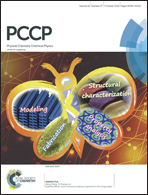The coupling of tautomerization to hydration in the transition state on the pyrimidine photohydration reaction path†
Abstract
The ground state reaction path for formation of the pyrimidine hydrates was calculated using a nudged elastic band (NEB) approach, combined with a calculation of the transition state, and implemented using a numerical basis set in the density functional theory (DFT) code DMol3. The model systems used for study consist of 1-methyl pyrimidines with a H2O molecule as the reactant, and the corresponding C5-hydro-C6-hydroxypyrimidine as the product. The barrier to addition of water across the C5–C6 π-bond ranges from 43–48 kcal mol−1 in the 1-methylpyrimidines (1-MP) studied. Similar but slightly smaller barriers of 34–45 kcal mol−1 were found for the tautomers of the 1-MPs, i.e. the enols of uridine and thymine and imine of cytosine. Comparison of these calculations with previous computational and experimental work suggests that a hot ground state formed by the rapid internal conversion of pyrimidines has sufficient energy to permit crossover from the common form to the tautomeric form of the pyrimidine at the transition state. The hot ground state mechanism can account for the experimentally observed yield and thermal reversion of pyrimidine photohydrates, while simultaneously explaining the effect of photohydrates on the mutation rate.


 Please wait while we load your content...
Please wait while we load your content...